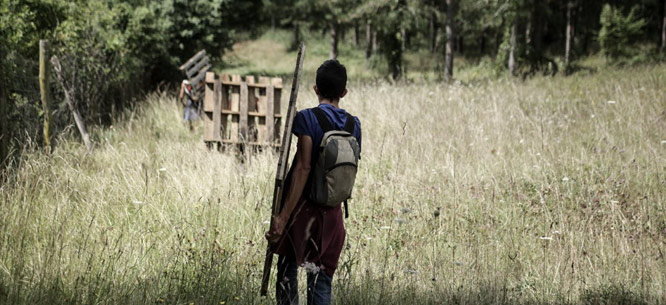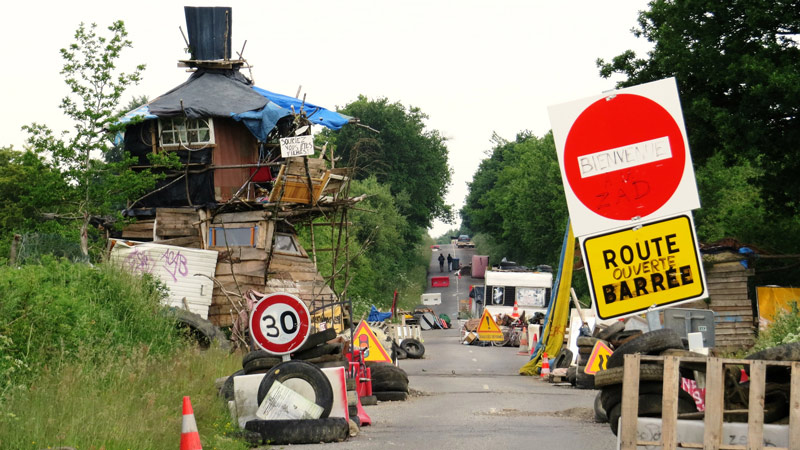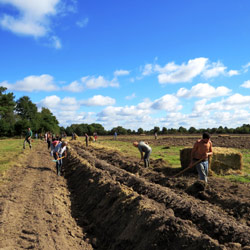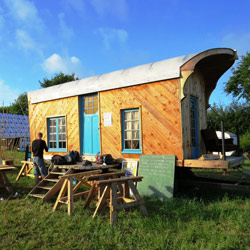France: Seeds of a New Green Left?
France: Seeds of a New Green Left?
Amid disenchantment with mainstream politics, tensions between Socialists and Greens, and a string of disappointments from outgoing president François Hollande, activists known as zadistes have taken the defense of the environment into their own hands—and met formidable police repression.

When it comes time to draw up the final reckoning of François Hollande’s troubled presidency, the pundits and historians who write its obituary will no doubt chalk his political demise up to France’s stubbornly high unemployment rate, market-oriented economic reforms, and the terrorist attacks of 2015-16. While all these are crucial pieces of the current French predicament, this narrative misses another entirely self-inflicted dimension of the French Socialists’ troubles. The terrible events that unfolded on the night of October 25-26, 2014 in the forest of Sivens in southwestern France not only illustrate social democracy’s ongoing failure to take the full measure of our epoch’s environmental challenges, they represented nothing short of a grave, even irreparable, blow to the Socialist president’s political fortunes.
Environmental activists had occupied the Sivens wood to block construction of a dam slated to provide irrigation water to local farms. Their face-off with police had grown increasingly tense in the preceding weeks. Around 2 a.m. on a night punctuated by violent clashes between law enforcement and protesters, gendarmes launched a concussion grenade which exploded near Rémi Fraisse, a twenty-one-year old botanist and environmental activist who was in Sivens for the first time, killing him.
Fraisse quickly became an incandescent symbol, throwing political fault lines into sharp relief, raising troubling questions about policing and democracy, and lending new urgency to environmental issues. Pitting an uncompromising technocratic state against ecological protest, the events at Sivens reenacted a familiar script. They served as both a brutal reminder of French Socialists’ history as reluctant environmentalists and a grave blow to their vexed partnership with the Green Party. More broadly, they fed mounting disappointment among those who had hoped that Hollande would seize on the widespread rejection of Nicolas Sarkozy’s erratic right-wing populism to chart a new progressive course for France.
But this tragedy has also trained a bright spotlight on new forms of radical left-wing protest that have emerged in recent years in France. At once a symptom of mounting disenchantment with mainstream politics in France and a testing ground for new modes of progressive politics, activists known as zadistes work outside traditional forms of political action to defend environmental causes in places like Sivens.
Fraisse’s death could not have come at a worse moment for a Socialist government already reeling from a virtually uninterrupted sequence of bad news, political miscalculations, and about-faces. Sluggish economic growth; embarrassing revelations concerning Hollande’s private life; and an increasingly vocal insurgency within the left wing of the Socialist party angered by the government’s centrist tack. In the wake of Fraisse’s death, Hollande’s approval ratings sagged to 13 percent, making him the least popular sitting president in the history of the Fifth Republic.This would have been a terrible ordeal for any government to face, but the death of a political demonstrator at the hands of the police takes on particular valence when the left is in power. In the modern French imaginary, heavy-handed repression of political dissent is the prerogative of order-loving right-wing governments. Indeed, Fraisse was the first demonstrator to lose his life under a left-wing government in the Fifth Republic’s nearly sixty-year history. As one high-ranking Socialist appalled by Fraisse’s death told Le Monde, “When you are on the left, when you were a left-wing activist for a long time before becoming a politician, all this inevitably sticks in your throat and leaves a bad taste in your mouth.”
As news spread of Fraisse’s death, it was impossible not to think back to the last time a demonstrator was killed by police in France. In December 1986, during a wave of student protests against a university reform being pushed by then–prime minister Jacques Chirac’s right-wing government, a student named Malik Oussekine was chased down and beaten to death by police as he was leaving a jazz club. Ever since, Oussekine’s memory has haunted every government confronted with large-scale political protest. Anxious to avoid loss of life and spare themselves Chirac’s electoral fate in the 1988 presidential elections, leaders have tread gingerly, directing police to abandon aggressive repression of demonstrations in favor of a strategy of broad restraint that has held until very recently.
But Socialist ministers would have done well to meditate a still closer precedent, whose uncanny similarities to the Sivens tragedy are symptoms of the longstanding dysfunctions of environmental democracy in France: the violent death, on July 31, 1977, of a physics teacher named Vital Michalon, during protests over the construction of a nuclear reactor in a village near the Swiss border. Superphénix, as the reactor was called, was slated to be the largest fast breeder reactor in the world. As the foundation for France’s strategic deterrent and guarantor of the nation’s energy independence in the wake of the mid-1970s oil shock, the nuclear program was not open to contestation in the eyes of France’s leaders. But the elevated risks presented by Superphénix’s use of plutonium fuel and highly flammable liquid sodium coolant alarmed environmental activists. A protest in summer 1977 met with formidable police response. In a pitched three-hour battle, one demonstrator lost his foot, another a hand; over a hundred were injured; and one slow-moving gendarme lost a hand to his own offensive grenade. Worst of all, Vital Michalon (who was among the vast majority of protesters who eschewed violence that day) lost his life when an offensive grenade exploded on his chest.French authorities quickly rolled out their cover-up. When the public learned two days later from the prosecutor’s office that the young man had in fact died in an explosion, the local Gendarmerie commander hastened to deflect suspicions from his own men, falsely accusing Michalon of accidentally killing himself with his own homemade bomb. The case against the police was ultimately dismissed, and Superphénix went on line in 1985.
Superphénix represents an important and paradoxical chapter in modern French history—at once a galvanizing moment in the formation of the environmental movement and a sobering example ofthe torturous triangulation of democracy, ecology, and raison d’État. Michalon’s death also showed the price the state was willing to pay to defend its own technocratic vision of French grandeur. That the left renewed France’s commitment to its nuclear program after Mitterrand’s election in 1981—even dispatching secret operatives to New Zealand to blow up the Rainbow Warrior, a Greenpeace vessel protesting French nuclear testing in the South Pacific—seemed only to confirm that environmentalists had little to hope for from the Socialists.
Happily, the last two decades have signaled something of a break from the Fifth Republic’s anti-environmentalist ethos, even offering hope that ecological and socialist politics might make fruitful common cause. Abandoning its “neither right nor left” line in the mid-1990s, the French Green Party has ever since clearly positioned itself on the left—indeed, on many issues, to the left of the French Socialist Party. As prime minister between 1997 and 2002, the Socialist leader Lionel Jospin seized the opportunity to broker a rapprochement, theorizing the Gauche plurielle, a broad left-wing coalition that spanned Communists and Greens. One of Jospin’s first decisions in 1997 was to shut Superphénix, a condition for Green participation in the government (Jospin’s first environment minister, Green chief Dominique Voynet, had been active in the fight against Superphénix). This decision was itself a tacit admission that the project had been a profligate technocratic folly all along: the reactor cost 12 billion euros to build and operate, produced power in only four-and-a-half of the eleven years it was in service due to safety and technical problems, and will cost at least a billion euros more to dismantle.As they learned to govern together in local and national governments, the two parties came to be seen as natural allies. It has never been an easy partnership, and the Greens’ penchant for interminable internecine quarrels hasn’t helped their own cause. But the Greens successfully reinvented themselves as a party of government backed by a sizable electoral base, reaching their high-water mark in the 2009 European elections when they won over 16 percent and became France’s third-biggest party. Given how popular core Green issues are in France—opposition to genetically modified crops, support for reducing greenhouse gas emissions, and mounting worries over France’s reliance on nuclear power—to a certain extent they have only themselves to blame for their more recent tribulations.
Perhaps the greatest testament to the Greens’ success is how loudly the French right came to trumpet their ideals—in discourse, at least, if not in action. As president, Chirac waxed lyrical on the dangers facing the planet, famously warning at the 2002 Earth Summit in Johannesburg that “our house is on fire and we are looking the other way.” Nicolas Sarkozy pushed an ambitious environmental agenda at the start of his presidency, before abandoning much of it along the way. In 2010, he complained in business-friendly exasperation that he’d “had about enough” of environmental issues. As Voynet, Jospin’s environment minister, once quipped, “right-wing ecology is first and foremost right-wing. While left-wing ecology is first and foremost ecological.”
True to post-1997 form, the Greens (who had renamed themselves Europe Écologie les Verts, or EELV, in 2010) once again made common cause with the Socialists during the 2012 presidential and legislative elections. Hollande didn’t promise them the ecological moon, but he did incorporate a certain number of environmental planks into his platform, committing for example to close Fessenheim, the oldest nuclear power plant still operating in France. He named two Greens to his first cabinet and extended a moratorium on fracking.But the new administration’s ecological commitments quickly revealed themselves weak. Hollande’s first prime minister, Jean-Marc Ayrault, carried with him an environmental original sin that would come to poison Hollande’s entire presidency. As mayor of Nantes, he made his own a project imagined by the state in the 1960s and reactivated by the Jospin government: the construction of a new airport at Notre-Dame-des-Landes (NDDL), a bocage, heath, and wetland area twenty kilometers outside the city. Ayrault and fellow boosters argued that a major international airport was the key to the city’s future development. Critics countered that the project was unnecessary: already well integrated into France’s high-speed rail network, the city’s existing airport is more than sufficient for a city of Nantes’ size. A new airport warranted neither the expenditure of a half-billion euros in public funds, nor resort to a costly public-private partnership (from which public works giant Vinci stood to profit handsomely), nor the destruction of a wetland, nor the expropriation of roughly fifty small farmers.

(Non à l’aéroport Notre-Dame-des-Landes / Flickr)
As the project moved forward through the planning and approval phases in the 2000s, local farmers, elected officials, and environmentalists linked up to oppose the airport, organizing marches, public debates, lawsuits, and hunger strikes. While a handful of activists began occupying the 4,000-acre site as early as 2007, the movement took on real momentum when the 2009 Camp for Climate Action was organized at NDDL. The camp drew a diverse range of participants, encompassing traditional environmental NGOs as well as a constellation of parties and organizations representing the French far-left: the Trotskyist Nouveau Parti Anticapitaliste, the Front de Gauche coalition (encompassing the Communist and other far-left parties), the alter-globalization association ATTAC, and anarchists and autonomists.
By the time Ayrault moved into the prime minister’s palace in 2012, NDDL had already become the biggest environmental battleground in France. A small cadre of activists had stayed on after the 2009 camp, transforming the site into an ongoing experiment—part political protest, part human shield against Vinci’s bulldozers, part testing ground for new forms of post-capitalist, environmentally sustainable communities. Restoring abandoned farmhouses and erecting new buildings, inhabitants have launched upwards of twenty different farming projects, including a vegetable garden tended in common, goat and cow herds, cheese- and butter-making, and beekeeping. Governed by egalitarian and self-management principles with a strong feminist stamp, decisions are made by consensus in general meetings, and work groups are organized on a volunteer basis. Seizing upon one of the multitude of technocratic acronyms that are the lexical building-blocks of the French state’s peculiar poetry, they declared the site a “ZAD,” transforming Zone d’aménagement différé (parcels of land slated for future public development where the state holds the right of first refusal) into Zone à défendre (Zone To Be Defended), and baptized themselves zadistes. Some have lived there continuously since the start—the community already counts several children born on the ZAD—though most are only at NDDL part-time.
The zadistes are a heterogeneous group, counting environmental activists tied to institutional ecological associations, anticapitalists of all stripes, and farmers linked to the anti-productivist Confédération Paysanne farmers’ union. Pacifists rub shoulders with those prepared to deploy black-bloc tactics against the police. Some look to the past for inspiration, seeing in NDDL an heir to the Larzac, a plateau in southern France where mass protests blocked the extension of a military base in the 1970s, and where many ecologically engaged farmers subsequently settled (playing a crucial role in the foundation of Confédération Paysanne). Others nurse a more radical vision, seeing in the ZAD a laboratory in which to test what post-capitalism might look like: they call the world of consumer capitalism and wage labor babylone; most seek anonymity, and the rare zadistes who deign to speak to journalists always identify themselves as “Camille”; placing little faith in more mainstream forms of political action like elections and strikes, some burn their voter registration cards.
The ZAD’s radical off-the-grid ethos hasn’t impeded partnerships with mainstream environmental groups to mount more traditional forms of mobilization. In May 2013, for example, tens of thousands of demonstrators created a human chain surrounding NDDL. While dialogue between zadistes and local inhabitants has not always been easy, nearby farmers who share opposition to the airport have found common ground with activists, offering support, helping them plant their first market garden in spring 2011, repeatedly driving their tractors to the ZAD to help ward off gendarmes, and joining in discussions of the site’s future, imagined as a collectively managed territory where new farmers might settle.
 |
 |
 |
From the start, the French state viewed this new form of activism with great suspicion. The authorities placed NDDL under close police surveillance, stationing more than a thousand riot police there on a permanent basis. In October 2012, Ayrault’s government launched a massive police operation—code-named César—mobilizing over 2,200 officers in an unsuccessful attempt to dislodge the zadistes. Leaving many injured and numerous buildings destroyed, the assault proved a decisive turning point in the ZAD’s history, bringing the movement to public attention and winning considerable sympathy. Several weeks later, tens of thousands of protesters converged on the site in support, and more people began joining the ZAD. In late 2012, less than 200 were living on the site; the next year their numbers more than doubled. Smarting from this public relations disaster, the government pulled law enforcement from the site altogether.
The NDDL experiment heralded a new form of environmental action, inspiring others to form ZADs in opposition to other development projects. By 2015, there were roughly thirty active ZADs across France. Just as at NDDL, environmental protests elsewhere have met with harsh police responses—even as courts have, in several cases, sided with the protesters. The ZAD at Roybon, for example—not far from the shuttered Superphénix—aims to stop the construction of a tropical-themed “Center Parc” resort that would welcome thousands to giant pools in the Alps, heated year-round. In a classic example of how pro-development étatisme so often runs roughshod over the official bodies ostensibly designed to weigh ecological concerns, the government overrode the environmental and water protection agencies who had rejected the project as a threat to waterways and aquafiers. The project was set to go ahead until the zadistes set up camp. It has since been halted by an appeals court.
So when activists raised the ZAD banner at Sivens, the government, desperate to prevent another NDDL-like movement from taking root, hastily dispatched a substantial gendarmerie contingent. In the weeks preceding Fraisse’s death they aggressively sought to dislodge the zadistes from Sivens. In the face of stiff resistance, the state escalated its repression.Hollande’s government’s missteps in the days following Fraisse’s death eerily recalled the Superphénix coverup—proof that many French leaders had learned little since 1977. Authorities communicated with stilted parsimony, omitting that they were aware of the gendarmerie‘s responsibility from the beginning until the prosecutor charged with the investigation went public nearly three days later, even neglecting to offer any expressions of sympathy to the young man’s family. In the days following the accident, gendarmes took a page from their Superphénix playbook and leaked the false lead that Fraisse might have been carrying his own explosives in his backpack. Manuel Valls, who had replaced the politically spent Ayrault as prime minister back in April, and who made his own tough-on-crime name as Hollande’s first interior minister, rushed to defend law enforcement.
Not bothering to interview a single protester present that night, the gendarmerie‘s internal affairs bureau concluded in its initial investigation that the officers at Sivens had acted “with professionalism and restraint” in a “logic of deescalation”—notwithstanding that, according to the same report, gendarmes had fired 237 tear-gas grenades, thirty-eight mixed explosive/tear-gas grenades, twenty-three offensive grenades, and forty-one flashballs. In a tacit admission of fault, then-interior minister (and currently prime minister) Bernard Cazeneuve moved to ban the use of offensive grenades—something that Michalon’s father had called for forty years earlier—and tighten rules governing the use of other types of grenades.
The Socialist government didn’t just defend the police, they went on the offensive, indiscriminately attacking zadistes and Greens in an effort to discredit protest methods and environmental imperatives alike. Earlier in the year, Ayrault had all but accused his own housing minister, Green leader Cécile Duflot, of complicity with the violent elements at NDDL (notwithstanding her consistent commitment to nonviolence). Bizarrely, Cazeneuve accused José Bové—a sheep farmer who had moved to the Larzac in the 1970s, served as Confédération Paysanne spokesperson, captured international attention for his battle against McDonald’s, and is currently a Green member of the European Parliament—of somehow sharing “responsibility” for Fraisse’s death. The FNSEA, the powerful farmers’ union that has helped co-govern France’s productivist agriculture policy since 1946, doubled down on its uncompromising support for projects like the Sivens dam. During a nationwide day of action protesting environmental regulations allegedly weighing on farmers, demonstrators lit a fire in front of a tax collection bureau in Valence and dumped manure on the Green Party’s offices in Toulouse. That the FNSEA’s spectacular, at times violent, modes of protest are tacitly tolerated by French authorities only highlights the repressive double standard to which environmental activists are held.
Police showed no such clemency towards the protests sparked by Fraisse’s death. In the weeks following, students blocking dozens of high schools met with a stern response. Toulouse and Paris and were the scene of pitched battles between protesters and police over successive weekends.
For Greens feeling increasingly isolated by Ayrault’s white elephant of an airport, Valls and Cazeneuve’s anti-environmental intransigence, and the government’s repressive posture, Sivens was the final straw. Since 2012, Hollande’s wavering environmental commitments had already given environmentalists plenty of reason for worry. The Environment Ministry’s budget has suffered steep cuts; when Socialist environment minister Delphine Batho protested in 2013, she was sacked. The president too has been quick to retreat from major environmental initiatives whenever buffeted by political headwinds. Take the Écotaxe on heavy trucks, aimed at reducing diesel emissions and supporting rail and waterborne shipping alternatives, voted with near unanimity under Sarkozy, and whose nearly 1 billion euros of annual revenues were slated to fund investment in low-carbon transportation infrastructure. A grassroots taxpayer revolt in Brittany spooked Hollande into reversing course on the eve of implementation. He forced the government to break its contract with the company charged with collecting the tax, thereby burdening taxpayers with nearly 1 billion euros in penalties.
Aware that his own government’s handling of Sivens was playing poorly in public opinion, Hollande suddenly began proffering confessions of ecological faith. In a speech a month later at the Fondation Chirac, Hollande quoted the former president’s “our house is burning” speech, adding piously, “I fear that it may already be entirely consumed.” He threw France’s full diplomatic weight behind the push for ambitious results at the United Nations Climate Change Conference in Paris in December 2015. Just days before the Chirac Foundation speech, he had been singing the praises of French petroleum giant Total’s massive investments in Alberta’s tar sands.
It is a perverse irony that the Charlie Hebdo/Hyper Cacher attacks, by chasing Sivens from headlines and inspiring a sentiment of national unity ten weeks after Fraisse’s death, threw a political lifeline to Hollande, Valls, and not least Cazeneuve, who had come perilously close to being ejected from the cabinet. With anti-terrorism now the order of the day, the government took full advantage of the broad policing powers at its disposal under the state of emergency to target environmental activists. During the COP21 summit, the government clamped down on anti-global warming demonstrations and placed twenty-four environmentalists under preventive house arrest.Ever the consummate tactician, if also the blundering strategist, Hollande seized the opportunity Sivens had created and the cover the January attacks provided to whittle the Greens’ influence. Already by April 2014, Valls’s appointment as prime minister had driven EELV leader Cécile Duflot, along with development minister (and current head of the French WWF) Pascal Canfin, from the cabinet. Duflot continued to clash with Valls over NDDL, immigration, the state of emergency, and a proposed law to strip convicted terrorists of French citizenship. Still at that point nursing reelection ambitions, and gambling that the absence of a strong EELV candidate would boost his own chances of making it out of the election’s first round, Hollande sought to deliver a death blow to the Greens by dividing them: tempting away centrist Greens with cabinet positions, while driving Duflot and others towards the far-left Front de Gauche. It worked. By fall 2015, breakaway Greens led by Jean-Vincent Placé created a new party, the Union des Démocrates et des Écologistes, allied with the PS, and Placé was duly rewarded with a government portfolio. Bleeding elected officials to other parties, the EELV lost more than half their Eurodeputies and roughly 200 regional councillors, was reduced to a rump force in the National Assembly, and had to plead for donations to absorb yawning deficits.
Hollande’s clinical butchering of the EELV wasn’t just cynical or self-serving, it was suicidally short-sighted. No Socialist president or legislative majority since 1997 has been possible without Green support. Were it to last, this PS-Green divorce would have serious consequences for French political life, significantly weakening the left and worsening existing divisions within the PS.
Where do things stand now? As of this writing, judges investigating the Fraisse case are expected to recommend dismissing all charges; Fraisse’s family is preparing to file their own charges against the prefect and several gendarmes. Environmental groups pursued their battle against the dam in the courts, arguing that the project violates French environmental regulations. Shortly after Fraisse’s death, the European Commission (which had committed nearly a quarter of the dam’s funding) found that the project violated European water and environmental rules and declared the French environmental impact statements inadequate. As for Ségolène Royal, environment minister since 2014, she sought to ride out the political storm with noncommital prudence, drawing out the decision-making process on the one hand, allowing police to dislodge the zadistes in spring 2015 on the other, before quietly pulling the plug on the dam on Christmas Eve 2015 (there is vague talk today of a smaller dam).Meanwhile, at NDDL, Valls repeatedly expressed his determination to begin construction. The government shrewdly organized a local referendum in June 2016 in an attempt to shroud the project with some semblance of democratic legitimacy: 55 percent voted yes, though the communities closest to NDDL voted no, and the entire exercise begged the question: What of the French and European environmental agencies’ negative assessments? Shouldn’t large infrastructure projects be the subject of informed national debate? Royal began to call on her own camp to “cut our losses” and cancel the airport. When Valls stepped down as PM last December to embark on his ill-fated run for president, the government lost any political will in favor of the airport, making the matter moot. In a book of interviews with journalists published last fall, Hollande himself confessed that the airport “will never see the light of day”—a candid admission whose full implications are appalling: that nearly a decade of grinding, costly confrontation over an ill-conceived project championed by local power barons, infrastructure-besotted technocrats, and private interests, had come to be prosecuted as an exercise in political face-saving. For nought.
Hollande will brag that he helped make COP21 a success. It is the climate-change agreement tree that hides a forest littered with broken environmental promises, dialogues refused, expertise ignored, protests repressed, and alliances betrayed. Hollande’s 2012 campaign promise to close the forty-year-old Fessenheim nuclear plant will remain unfulfilled when he leaves office later this spring. Although his flagship Energy Transition law committed to reducing the share of nuclear power in France’s energy mix from 75 to 50 percent, environment minister Royal blithely affirmed the government’s support for building new reactors in January 2015. And that leaves aside his torpedoing of the Socialist-Green alliance that has formed the foundation for left-wing governments at the local and national levels for over two decades midway through his presidency.
For those in France committed to forging a progressive politics that allies social justice with an environmental agenda worthy of the name, there is now some flicker of hope. Benoît Hamon’s unexpected victory in the Socialist primary, and his alliance with EELV leader Yannick Jadot, not only moves the PS’s cursor firmly to the left, it places an ambitious environmental program squarely at the heart of the its platform. Doubtless too late to sway this spring’s elections—as Hamon’s sagging poll numbers have only confirmed—but perhaps enough to help rebuild a progressive left-ecological movement for the future.
Meanwhile, as globalization’s environmental and social costs become increasingly unbearable, we should pay close attention to what is happening in the ZADs themselves. NDDL and its far-flung self-governing satellites may fly below the radar of our age’s breathless news cycle most of the time, but they point towards political and social possibilities that should command our attention. The zadistes may not have all the answers, but at least they are asking the right questions.
Paul Cohen is an associate professor of history at the University of Toronto.






